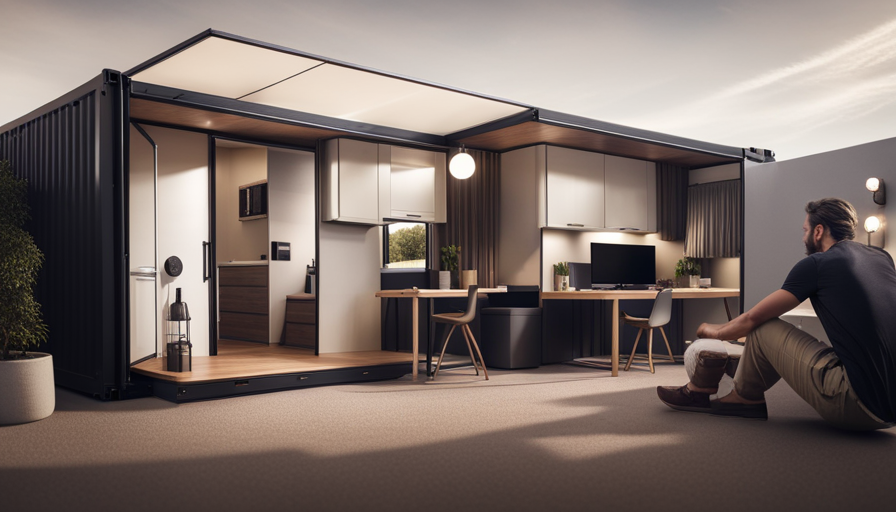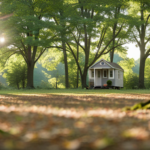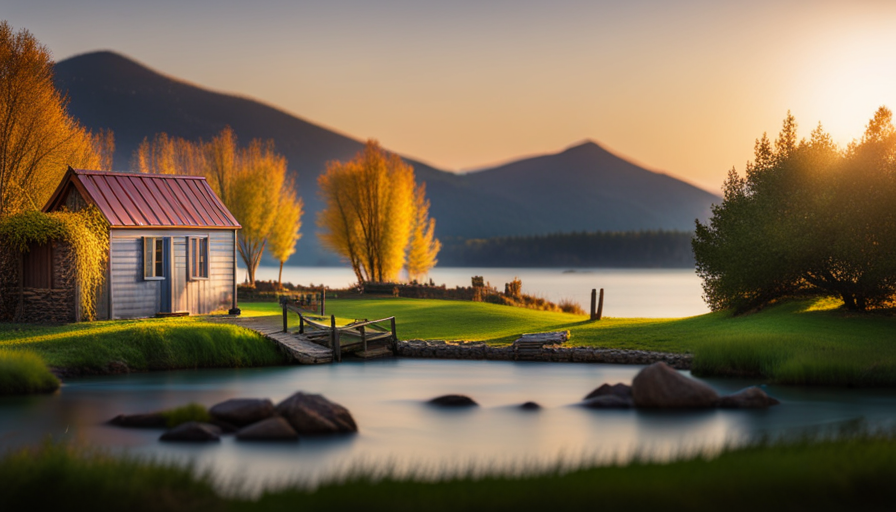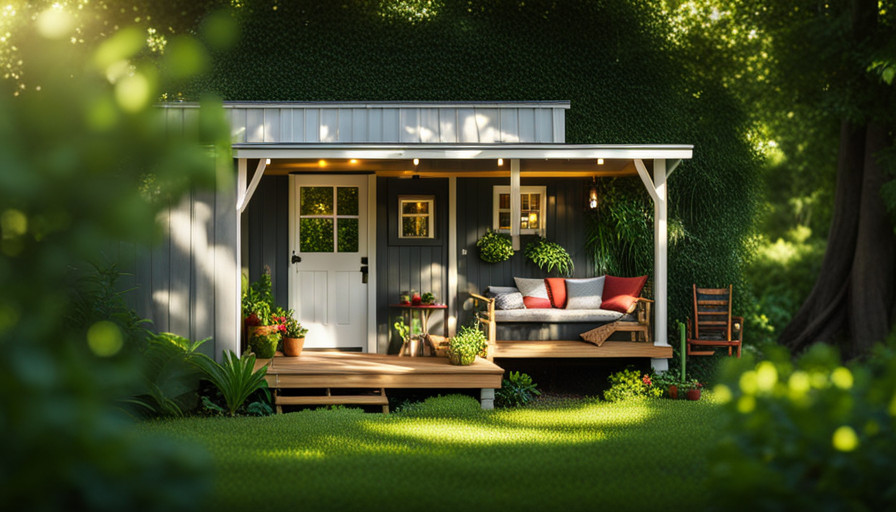Have you ever imagined building a lively and eco-friendly community in the center of Washington State? A place where individuals can embrace a minimalist lifestyle, connect with nature, and cultivate a deep sense of community? If this resonates with you, then starting a tiny house village could be the ideal project for you.
In this article, I will guide you through the process of turning your vision into a reality. We will explore everything from researching zoning regulations and permit requirements to identifying potential funding sources. Together, we will find the perfect location for your village and develop a comprehensive business plan.
We will delve into the design and construction of the tiny houses, as well as creating shared spaces and amenities. Sustainability and eco-friendly practices will be at the forefront of our efforts, ensuring a greener future.
Lastly, we will discuss how to effectively market and advertise your village, fostering a strong and supportive community spirit.
So, let’s embark on this exciting journey and make your dream of a tiny house village in Washington State come true.
Key Takeaways
- Conduct thorough research on zoning regulations and permit requirements in Washington State.
- Explore potential funding sources such as crowdfunding, corporate sponsorships, grants, and foundations.
- Consider location factors such as zoning regulations, proximity to amenities, land condition, and infrastructure needs.
- Develop a comprehensive business plan including financial projections and revenue streams.
Research Zoning Regulations and Permit Requirements
So, you’re thinking about developing a tiny house village in Washington state? Well, let’s dive into researching the zoning regulations and permit requirements to make sure we’re on the right track!
In order to successfully develop a tiny house village, it’s crucial to understand the specific zoning regulations and permit requirements in the area you’re looking to build. Start by exploring local partnerships with organizations and individuals who’re knowledgeable about the local zoning laws. Engage with community leaders and attend public meetings to gain insight into any potential challenges or opportunities that may arise during the development process.
As you research the zoning regulations, be sure to pay attention to any restrictions or limitations on the size and placement of tiny houses. Some areas may require minimum lot sizes or specific setbacks from property lines. Additionally, familiarize yourself with the permit requirements for construction, utilities, and sewage systems. It’s important to ensure that your tiny house village meets all necessary safety and health standards.
Once you have a clear understanding of the zoning regulations and permit requirements, you can then move on to identifying potential funding sources for your project. Transitioning into the next section, it’s essential to explore various avenues for financing in order to make your tiny house village a reality.
Identify Potential Funding Sources
Imagine a world where you’re the captain of a ship and your mission is to uncover hidden treasure chests brimming with financial support for your noble cause. As you set sail on this funding adventure for your tiny house village in Washington State, there are various sources you can explore to make your dream a reality.
-
Crowdfunding: Tap into the power of the crowd by creating a compelling campaign on platforms like Kickstarter or GoFundMe. Share your vision, highlight the benefits of a tiny house village, and offer attractive rewards to entice potential donors. Leverage social media and engage with your audience to create a sense of community and inspire them to contribute.
-
Corporate sponsorships: Seek support from local businesses or organizations that align with your mission. Approach them with a well-crafted proposal outlining the benefits of sponsoring your tiny house village. Emphasize the positive impact it’ll have on the community, the potential for media coverage, and the opportunity for them to showcase their commitment to sustainability and affordable housing.
-
Grants and Foundations: Research and apply for grants from foundations that support affordable housing initiatives. Look for organizations with a focus on community development, sustainable living, or social welfare. Craft a strong grant proposal highlighting the unique aspects of your project and its potential to address housing challenges in Washington State.
By securing funding through crowdfunding, corporate sponsorships, and grants, you can bring your vision of a tiny house village to life. With the financial support in place, it’s time to embark on the next step: finding the perfect location for your community.
Find the Perfect Location for Your Tiny House Village
Discover your ideal spot to establish a charming community of compact homes, where residents can enjoy an eco-friendly lifestyle amidst nature’s beauty. Finding suitable land is crucial for developing a tiny house village in Washington State.
Begin by researching areas that have zoning regulations allowing for tiny houses or are open to the idea of alternative housing options. Consider factors such as proximity to urban centers, public transportation, and access to amenities like grocery stores and healthcare facilities. It’s also essential to evaluate the condition of the land, ensuring it’s suitable for development and meets any necessary environmental requirements.
As you search for the perfect location, don’t forget to consider infrastructure needs. Access to water, electricity, and sewage facilities are vital for the successful operation of a tiny house village. Look for areas that already have existing infrastructure or can easily accommodate the necessary upgrades. Additionally, consider the potential for renewable energy sources, such as solar panels or wind turbines, to make the village more sustainable.
Finding the right location is a critical step in developing a tiny house village in Washington State. By carefully considering zoning regulations, proximity to amenities, and infrastructure needs, you can ensure the success and sustainability of your community. With this groundwork laid, it’s time to move on to the next section and develop a comprehensive business plan, outlining your vision and strategies for making your tiny house village a reality.
Develop a Comprehensive Business Plan
When creating your business plan, you’ll need to carefully outline your goals and strategies to ensure the success of your community of compact homes in Washington State. It’s crucial to form strategic business partnerships to support the development of your tiny house village. Seek out local organizations, such as non-profits or community development agencies, that share your vision and can provide resources or expertise.
Additionally, consider partnering with local businesses, such as construction companies or landscaping services, to help with the development and maintenance of the village.
Financial projections are also an essential component of your business plan. Conduct thorough research to estimate the costs involved in purchasing land, obtaining necessary permits, and constructing the tiny houses. Consider potential revenue streams, such as rental income or community fees, to determine the financial viability of your project. It’s important to be realistic and conservative in your projections to ensure long-term sustainability.
Developing a comprehensive business plan for your tiny house village in Washington State requires careful consideration of business partnerships and financial projections. These elements are instrumental in creating a solid foundation for your project’s success.
Next, we will explore how to design and construct the tiny houses.
Design and Construct the Tiny Houses
To bring your vision to life, you’ll need to create the most innovative and jaw-droppingly stylish homes for your community of compact residences in the breathtaking state of Washington. When it comes to designing and constructing tiny houses, every inch matters. You want to maximize space and functionality while ensuring an aesthetically pleasing and comfortable environment for your residents.
When it comes to interior design ideas for tiny houses, think smart storage solutions and multipurpose furniture. Utilize wall-mounted shelves, built-in cabinets, and hidden compartments to optimize every nook and cranny. Consider incorporating lofted beds or fold-out tables to save space during the day. Experiment with color schemes and lighting to create the illusion of larger spaces.
Innovative construction materials are also crucial in building tiny houses. Look for sustainable and lightweight options that can withstand the elements. Consider using reclaimed wood, recycled metal, or even eco-friendly concrete alternatives. These materials not only reduce the environmental impact but also provide durability and insulation.
By focusing on interior design ideas for tiny houses and utilizing innovative construction materials, you can create unique and functional homes that reflect the beauty of Washington.
With the groundwork laid, it’s time to establish community guidelines and rules to ensure a harmonious and thriving village.
Establish Community Guidelines and Rules
Get ready to establish some community guidelines and rules that’ll ensure a harmonious and thriving village for all its residents! To create a strong sense of community engagement, it’s essential to involve all residents in the decision-making process. Conduct regular meetings where everyone can voice their opinions and concerns. Encourage open communication and active participation from all members to build a supportive and inclusive environment.
Addressing safety concerns is of utmost importance when establishing community guidelines. Develop clear rules regarding fire safety, emergency protocols, and general security measures. Ensure that all residents are familiar with these guidelines and have access to necessary safety equipment. Regular inspections should be conducted to identify and address any potential hazards.
In addition to safety, it’s crucial to establish guidelines for noise levels, pet policies, and maintenance responsibilities. Encourage mutual respect and consideration among residents to maintain a peaceful living environment. Clearly outline expectations for cleanliness and upkeep of individual tiny houses and common areas.
By establishing these community guidelines, we can create a safe and cohesive village where everyone feels valued and respected. With these guidelines in place, we can now move on to the next step: creating shared spaces and amenities that’ll foster a sense of belonging and enhance the overall quality of life in our tiny house village.
Create Shared Spaces and Amenities
Imagine a village bursting with vibrant shared spaces and amenities that’ll leave residents in awe and make them feel like they’re living in a luxury resort.
Shared spaces are essential in creating a sense of community and fostering social interaction among residents. In our tiny house village, we’ll prioritize the development of beautifully landscaped parks, gardens, and playgrounds where neighbors can gather, relax, and enjoy the outdoors. These spaces will be designed to accommodate various activities, such as yoga classes, outdoor movie nights, and community picnics.
To further encourage community engagement, we’ll also create communal areas like a clubhouse, a community kitchen, and a fitness center. These spaces will provide opportunities for residents to come together, share meals, and engage in recreational activities. The clubhouse can be used for hosting events and workshops, while the community kitchen will allow residents to cook and share meals together. Additionally, the fitness center will promote a healthy lifestyle and provide a space for residents to exercise and stay active.
By incorporating these shared spaces and amenities into our tiny house village, we aim to create a strong sense of belonging and encourage socialization among residents. These spaces will foster a supportive and inclusive community where neighbors can build lasting friendships and create lifelong memories.
As we move forward and promote sustainability and eco-friendly practices, we’ll ensure that these shared spaces are designed and maintained with the environment in mind.
Promote Sustainability and Eco-Friendly Practices
Now that we’ve created shared spaces and amenities within our tiny house village in Washington State, it’s time to focus on promoting sustainability and eco-friendly practices. This is a crucial aspect of developing a community that not only benefits its residents but also contributes positively to the environment.
To begin with, we’ll implement green building techniques throughout the village. This means using sustainable materials, such as reclaimed wood or recycled building materials, for construction. Additionally, we’ll prioritize energy-efficient design principles, like proper insulation and passive solar heating, to minimize our ecological footprint.
In terms of energy consumption, we’ll explore renewable energy options to power our village. Installing solar panels on the rooftops of each tiny house and using wind turbines will allow us to generate clean and sustainable energy. Furthermore, we’ll encourage residents to adopt energy-saving habits, such as using energy-efficient appliances and practicing responsible water usage.
By incorporating these green practices into our tiny house village, we aim to create an environmentally conscious community that showcases the potential of sustainable living. Our commitment to promoting sustainability not only benefits our residents but also serves as a model for other communities to follow.
As we delve into the next section about marketing and advertising our tiny house village, we’ll explore effective ways to showcase the unique features and benefits of our eco-friendly community.
Market and Advertise Your Tiny House Village
To effectively promote and market your sustainable community, you’ll want to highlight the unique features and benefits that make it a truly one-of-a-kind living experience. Implementing effective social media marketing strategies and forming collaborative partnerships with local businesses can greatly enhance your outreach efforts.
Social media platforms like Facebook, Instagram, and Twitter provide excellent opportunities to showcase your tiny house village and engage with potential residents. Create visually appealing content, such as photos and videos, that highlight the eco-friendly features, beautiful surroundings, and sense of community within your village. Encourage residents and visitors to share their experiences on social media using specific hashtags related to your village.
In addition to social media, forming collaborative partnerships with local businesses can help increase your village’s visibility. Work with nearby restaurants, shops, and recreational facilities to offer exclusive discounts or promotions to residents. This not only benefits your residents by providing them with convenient amenities, but it also helps to generate positive word-of-mouth and attract more potential residents.
To effectively market your tiny house village, consider creating a table to highlight the unique features and amenities that differentiate your community from others. This will help potential residents understand the advantages of living in your village and make an informed decision.
By implementing strategic social media marketing strategies and forming collaborative partnerships with local businesses, you can effectively market and promote your tiny house village in Washington State. These efforts will attract residents who value sustainability, community, and a unique living experience.
Transition: By fostering a strong and supportive community spirit, residents will truly feel at home in our tiny house village.
Foster a Strong and Supportive Community Spirit
Creating a close-knit and supportive community environment is essential for ensuring that residents of our sustainable living community feel a true sense of belonging and connection. To foster a strong and supportive community spirit, we need to prioritize community events and volunteer opportunities that encourage residents to come together and actively contribute to the growth and well-being of our tiny house village.
Organizing regular community events is a great way to bring residents together and build a sense of camaraderie. We can plan activities like potluck dinners, movie nights, or even outdoor picnics where everyone can socialize and get to know each other. These events provide opportunities for residents to bond, share their experiences, and create lasting friendships within the community.
In addition to community events, offering volunteer opportunities is another effective way to strengthen the community spirit. By encouraging residents to volunteer their time and skills, we can tap into their unique strengths and passions, creating a sense of purpose and fulfillment. Volunteer opportunities can include organizing workshops, maintaining community gardens, or even teaching skills to fellow residents.
By prioritizing community events and volunteer opportunities, we can create a thriving and supportive environment where residents feel valued and connected. This will not only enhance the overall quality of life in our tiny house village but also ensure that residents have a true sense of ownership and pride in their community.
Frequently Asked Questions
How much does it cost to develop a tiny house village in Washington State?
Developing a tiny house village in Washington State can be a cost-effective endeavor. A detailed cost estimation is crucial to ensure efficient budgeting. Factors like land acquisition, permits, infrastructure development, and construction costs contribute to the overall expenses.
Construction timelines depend on various factors such as the size of the village and the number of houses to be built. With strategic planning and practical execution, it’s possible to create a thriving tiny house community within a reasonable budget and timeline.
What are the legal requirements for owning a tiny house in Washington State?
To own a tiny house in Washington State, it’s important to understand the legal requirements and zoning regulations. The legal requirements vary depending on the location and size of the house. It’s crucial to check with local authorities and obtain proper permits.
Zoning regulations may dictate where you can place your tiny house, such as in designated residential areas or tiny house communities. Compliance with these regulations is essential to ensure a smooth ownership experience.
How can I find investors or funding for my tiny house village project?
Finding potential investors for my tiny house village project can be a strategic process. I would start by identifying individuals or organizations who are interested in sustainable housing or have a passion for community development.
Networking events, online platforms, and local community groups can be great places to connect with potential investors. Additionally, exploring crowdfunding options like Kickstarter or GoFundMe can help raise funds from a larger pool of people who believe in my vision.
What are the potential challenges or obstacles in developing a tiny house village in Washington State?
Developing a tiny house village in Washington state poses several challenges. Zoning regulations can be a major obstacle, as they may restrict where and how the village can be built.
Additionally, gaining community support is crucial but can be difficult, as some residents may have concerns about property values or overcrowding.
However, with careful planning and collaboration with local officials and community members, these challenges can be overcome, making the dream of a tiny house village in Washington state a reality.
How can I ensure the sustainability and eco-friendliness of my tiny house village in Washington State?
To ensure the sustainability and eco-friendliness of my tiny house village in Washington state, I’ll focus on using sustainable building materials and incorporating renewable energy sources. I’ll choose materials such as reclaimed wood, recycled steel, and non-toxic insulation.
Additionally, I’ll install solar panels to generate electricity and utilize rainwater harvesting systems for water conservation. Implementing these strategies will minimize environmental impact and create a sustainable and eco-friendly community.
Conclusion
So there you have it, my friends! Creating a tiny house village in Washington state may seem like a daunting task, but with the right research, planning, and determination, it’s absolutely achievable. By following the steps outlined in this article, you can transform your dream into a reality.
Imagine a vibrant community where sustainable living is the norm, where neighbors support and uplift each other, and where the beauty of nature surrounds you at every turn. It’s time to make your mark and create a tiny house village that’ll leave a lasting impact on Washington state.
Let’s get started!
Hi, I’m Emma. I’m the Editor in Chief of Tiny House 43, a blog all about tiny houses. While tree houses are often associated with childhood, they can be the perfect adult retreat. They offer a cozy space to relax and unwind, surrounded by nature. And since they’re typically built on stilts or raised platforms, they offer stunning views that traditional homes simply can’t match. If you’re looking for a unique and romantic getaway, a tree house tiny house might just be the perfect option.
















